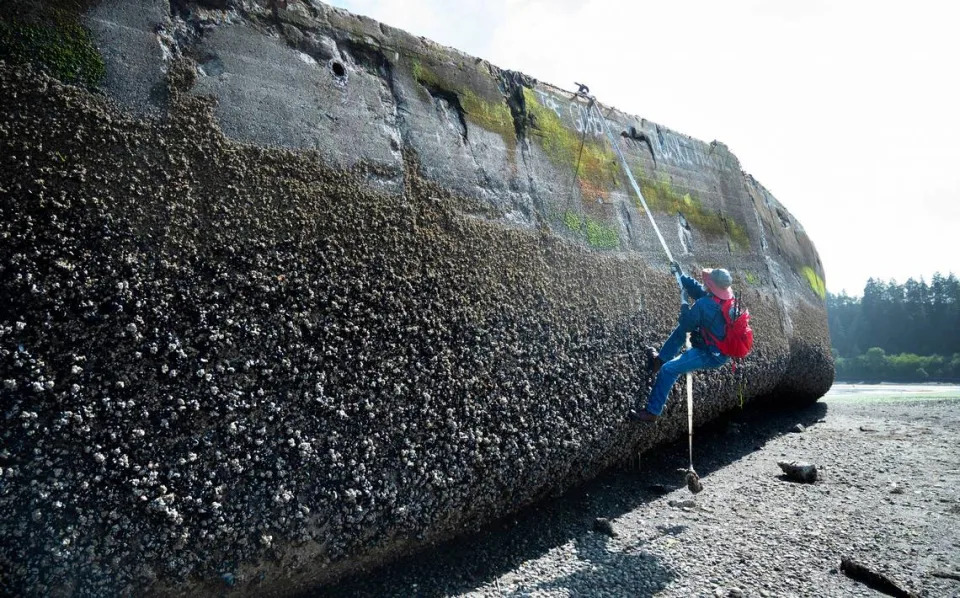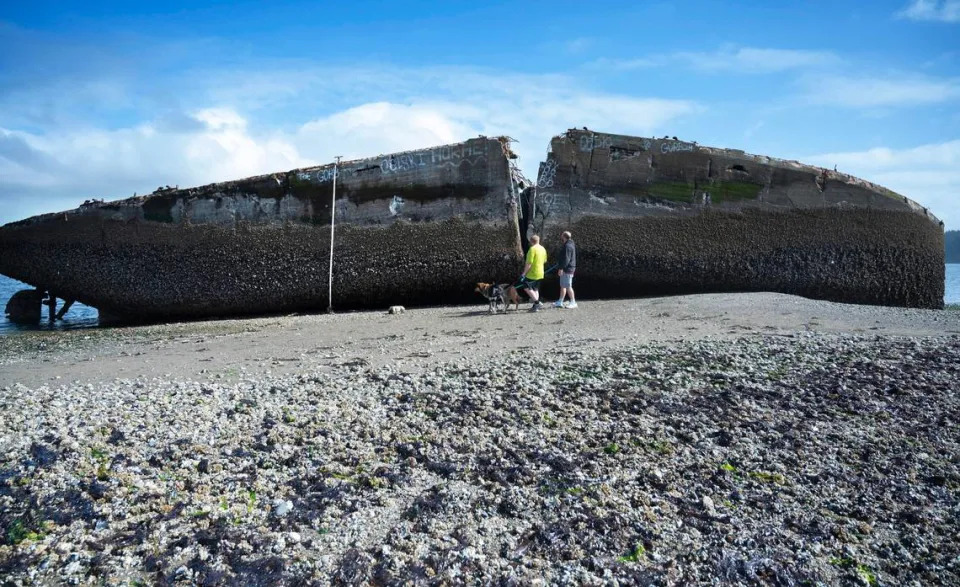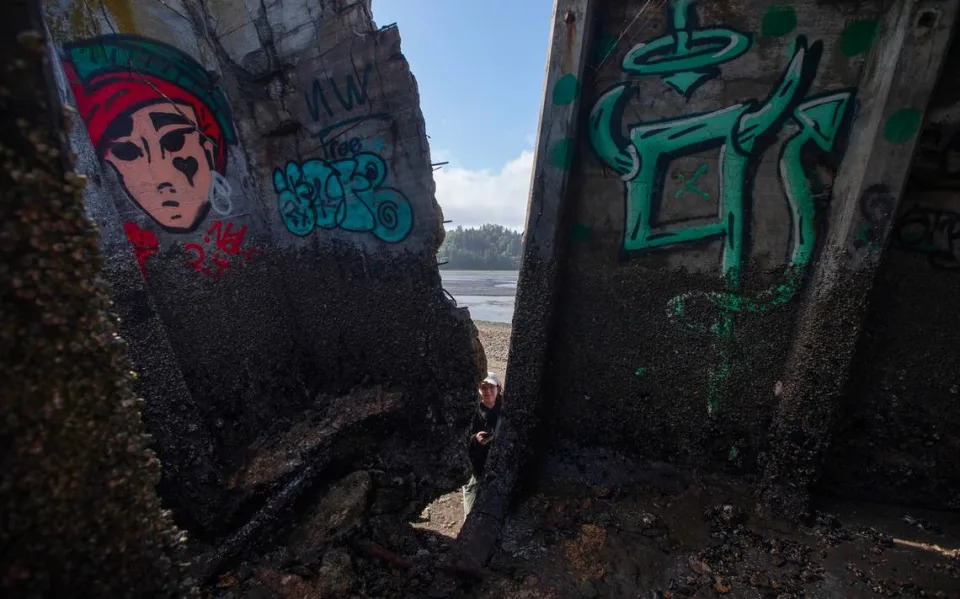WASHINGTON STATE
History of abandoned concrete barge in DuPont was mystery for years. Finally, answersBecca Most
THE NEWS TRIBUNE

Kaz Griffin of Tacoma climbs aboard The Cement Ship, the remains of a scuttled concrete barge on the beach in DuPont, Washington, on Wednesday, June 5, 2024.
The search for truth about ‘Concrete Hulk’
There’s been a lot of speculation about the “The Cement Ship” or “Concrete Hulk” over the years, and finding its history has stumped many archivists.
The News Tribune reached out to the DuPont Historical Society, Navy Region Northwest, the National Archives and Records Administration, the National Archives at Seattle, the Tacoma Public Library, the Foss Maritime Co., the Foss Waterway Seaport Museum and Pretty Gritty Tours before finding some answers. Most of those organizations had little to no information about the ship’s origins and history, sometimes to the surprise of their own researchers.
Carol Estep, with the DuPont Historical Society, told The News Tribune last week there wasn’t much information about the ship in the city’s archives. A visitor told her a couple years ago it might have been a cement oil barge used by the Navy.
Cmdr. J. Overton, with the Navy Region Northwest, told The News Tribune the local Navy museum had no information on the ship but believed it was a U.S. Army ship rather than a Naval vessel and recommended contacting the National Archives.
From there, the Branch Chief of the National Archives, Onaona Guay, told The News Tribune its textual-reference archivists suggested the barge was likely a merchant ship called the Captain Barker, but did not find any direct record matches in their archive branch.
A later search of the National Archives in Seattle found the “Cement Ship” in a list of merchant vessels of the United States under the name Captain Barker, according to director of Archival Operations Valerie Szwaya. It was built as a water tender in 1919 by the Great Northern Concrete Shipping Co. in Vancouver, Washington. Later it served as Foss 103 Barge and was home-ported in Seattle, Szwaya said.
Spencer Bowman is a reference and archivist librarian with the Tacoma Public Library’s Northwest Room. Bowman told The News Tribune after reviewing Northwest Room collections, including shipwreck literature, Foss maritime histories and the Ships and Shipping Database, “Regrettably, I found very little information on this cement ship, which was very surprising.”
The book “Exploring Maritime Washington” by Erich Ebel briefly listed the ship as a water tender built in 1919 that was later renamed Captain Barker and sunk in the 1970s, Bowman said. He recommended contacting the Foss Waterway Seaport Museum.
Nikola Troup, the operations and collections coordinator of the Foss Waterway Seaport Museum told The News Tribune on Friday she couldn’t find any mention of Captain Barker or Foss 103 in Foss logs or the museum’s database.
Foss Maritime chief operating officer Chris Mack Jr. told The News Tribune on Friday the company also did not have any supporting information on the ship nor any records of ownership.

Michael Ogle of Tacoma, brings his brother William Ogle of Carmel, Indiana, explore around The Cement Ship, a scuttled concrete barge on the beach in DuPont, Washington, on Wednesday, June 5, 2024.
A concrete ship experiment gone wrong
Chris Staudinger is co-founder, researcher and tour guide of Pretty Gritty Tours. Staudinger said after he received questions from locals about the concrete barge a few years ago, he started his own deep-dive investigation. What he found was consistent with other sources: The ship was indeed built by the Great Northern Concrete Shipbuilding Co. in 1919 and named the Captain Barker.
Staudinger pointed to a blog article written by concrete-ship enthusiasts Richard Lewis, an Irishman, and Erlend Bonderud of Norway, who have chronicled the history of concrete ships around the world, including the Captain Barker and several sister ships built in the same time period.
One of “The Crete Fleet” blogs titled, “WWI Concrete Water Tank Boats - Built in Vancouver, Washington” and published Aug. 13, 2023 explores the history of the first ocean-going concrete “tank boats” built to transport fresh water in the United States following World War I. Concrete ships were built as an experiment after a scarcity of vessels during wartime combined with a shortage of steel, the article said. Staudinger said people were also interested in exploring the durability and affordability of concrete as a shipbuilding material.
The Great Northern Concrete Shipbuilding Co. of Vancouver built five “tank boats” designed to carry 52,000 gallons of fresh water each. They were launched between Feb. 20, 1920 and May 31, 1920, according to the article. Only two of those ships survived more than one year and the rest sank as a result of storms.
“The boats were not properly constructed for sea trips, and the trip down the coast should never have been undertaken,” sea captains told the News-Pilot on Jan. 29, 1920 after the fact.
Staudinger said the shape of the ships made them ride too low in the water and made them easy to tip. He also believed there were no baffles inside the ships, which would have prevented the volume of water inside from causing a rocking motion with its kinetic force, thus making it less likely to flip over.

The interior of The Cement Ship, a scuttled concrete barge on the beach in DuPont, Washington, on Wednesday, June 5, 2024.
Captain Barker was one of the ships to survive longer than a year. It launched on March 3, 1919 but was placed in dry dock after its first sea trials found its steering ability unsatisfactory, according to “The Crete Fleet” article. Enos Crawford was assigned captain on Jan. 18, 1920 and the Captain Barker arrived in Astoria from Vancouver on Jan. 21, 1920, towed by tugboat USAT Slocum.
In October 1921 Captain Barker was offered for sale at Fort Canby, Astoria, and in June 1923 it was bought by Rouse Towboat Co., which was part of Foss Launch and Tug Co., with the plan to have the ship towed from Astoria to Seattle for use in local waters, the article said.
It was renamed Foss 103 and used as a sludge-disposal barge. In the mid-1960s it was scuttled as breakwater at the end of Nisqually Spit. At some point the boat split in two, likely the result of yawing in the tide, the article said.
A petition to dissolve the Great Northern Concrete Shipbuilding Co. was filed Oct. 9, 1920, bringing an end to the building of concrete tanks in Vancouver, according to the article. Another one of the ships’ sisters’ wrecks, the Captain Bootes, survives today in the breakwater of Everett, Washington.
Staudinger said Foss 103 was scuttled intentionally in an effort to stop ship traffic and waves from eroding the Nisqually Reach shoreline.
“This one was especially favorable for the action because of it being concrete,” he said. “They knew it was going to stick around for longer.”
Each of the ‘tank boats’ cost about $80,000 at the time, which equates to about $1.4 million today, according to “The Crete Fleet” article.

Walkers on the DD-Wilkes Observatory Trail, where a cutoff down a steep hillside takes you to The Cement Ship, a scuttled concrete barge on the beach in DuPont, Washington, on Wednesday, June 5, 2024.
If you visit
At the lowest tides you can walk to the “Concrete Hulk” by parking at DuPont Civic Center and following the Sequalitchew Creek Trail through a forested canyon to Puget Sound along Pebbles Beach. The trail follows the historic route of the Dynamite Train, which was owned by the DuPont Co. and ended at a wharf on Puget Sound to ship dynamite worldwide.
Tue, June 11, 2024
An abandoned concrete barge has been sitting off the coast of DuPont for more than 60 years. If you time it right, at low tide you can follow a long sandbar littered with barnacled logs and metal debris from an old wharf that sat in the Nisqually Reach and climb inside or on top.
The ship’s walls are scaly with slick black mussels and oysters peppered with crustaceans. Water drips off rusting steel beams that splay out from what remains of the concrete interior. Gulls and bald eagles squawk overhead as long-legged birds dip for fish in the surf nearby.
Not much is known about how the barge got there, what it carried, why it was made of concrete and how it came to rest, now split in half at the end of the Nisqually Spit. The News Tribune talked to nearly a dozen researchers and historians to find the answers.
An abandoned concrete barge has been sitting off the coast of DuPont for more than 60 years. If you time it right, at low tide you can follow a long sandbar littered with barnacled logs and metal debris from an old wharf that sat in the Nisqually Reach and climb inside or on top.
The ship’s walls are scaly with slick black mussels and oysters peppered with crustaceans. Water drips off rusting steel beams that splay out from what remains of the concrete interior. Gulls and bald eagles squawk overhead as long-legged birds dip for fish in the surf nearby.
Not much is known about how the barge got there, what it carried, why it was made of concrete and how it came to rest, now split in half at the end of the Nisqually Spit. The News Tribune talked to nearly a dozen researchers and historians to find the answers.

Kaz Griffin of Tacoma climbs aboard The Cement Ship, the remains of a scuttled concrete barge on the beach in DuPont, Washington, on Wednesday, June 5, 2024.
The search for truth about ‘Concrete Hulk’
There’s been a lot of speculation about the “The Cement Ship” or “Concrete Hulk” over the years, and finding its history has stumped many archivists.
The News Tribune reached out to the DuPont Historical Society, Navy Region Northwest, the National Archives and Records Administration, the National Archives at Seattle, the Tacoma Public Library, the Foss Maritime Co., the Foss Waterway Seaport Museum and Pretty Gritty Tours before finding some answers. Most of those organizations had little to no information about the ship’s origins and history, sometimes to the surprise of their own researchers.
Carol Estep, with the DuPont Historical Society, told The News Tribune last week there wasn’t much information about the ship in the city’s archives. A visitor told her a couple years ago it might have been a cement oil barge used by the Navy.
Cmdr. J. Overton, with the Navy Region Northwest, told The News Tribune the local Navy museum had no information on the ship but believed it was a U.S. Army ship rather than a Naval vessel and recommended contacting the National Archives.
From there, the Branch Chief of the National Archives, Onaona Guay, told The News Tribune its textual-reference archivists suggested the barge was likely a merchant ship called the Captain Barker, but did not find any direct record matches in their archive branch.
A later search of the National Archives in Seattle found the “Cement Ship” in a list of merchant vessels of the United States under the name Captain Barker, according to director of Archival Operations Valerie Szwaya. It was built as a water tender in 1919 by the Great Northern Concrete Shipping Co. in Vancouver, Washington. Later it served as Foss 103 Barge and was home-ported in Seattle, Szwaya said.
Spencer Bowman is a reference and archivist librarian with the Tacoma Public Library’s Northwest Room. Bowman told The News Tribune after reviewing Northwest Room collections, including shipwreck literature, Foss maritime histories and the Ships and Shipping Database, “Regrettably, I found very little information on this cement ship, which was very surprising.”
The book “Exploring Maritime Washington” by Erich Ebel briefly listed the ship as a water tender built in 1919 that was later renamed Captain Barker and sunk in the 1970s, Bowman said. He recommended contacting the Foss Waterway Seaport Museum.
Nikola Troup, the operations and collections coordinator of the Foss Waterway Seaport Museum told The News Tribune on Friday she couldn’t find any mention of Captain Barker or Foss 103 in Foss logs or the museum’s database.
Foss Maritime chief operating officer Chris Mack Jr. told The News Tribune on Friday the company also did not have any supporting information on the ship nor any records of ownership.

Michael Ogle of Tacoma, brings his brother William Ogle of Carmel, Indiana, explore around The Cement Ship, a scuttled concrete barge on the beach in DuPont, Washington, on Wednesday, June 5, 2024.
A concrete ship experiment gone wrong
Chris Staudinger is co-founder, researcher and tour guide of Pretty Gritty Tours. Staudinger said after he received questions from locals about the concrete barge a few years ago, he started his own deep-dive investigation. What he found was consistent with other sources: The ship was indeed built by the Great Northern Concrete Shipbuilding Co. in 1919 and named the Captain Barker.
Staudinger pointed to a blog article written by concrete-ship enthusiasts Richard Lewis, an Irishman, and Erlend Bonderud of Norway, who have chronicled the history of concrete ships around the world, including the Captain Barker and several sister ships built in the same time period.
One of “The Crete Fleet” blogs titled, “WWI Concrete Water Tank Boats - Built in Vancouver, Washington” and published Aug. 13, 2023 explores the history of the first ocean-going concrete “tank boats” built to transport fresh water in the United States following World War I. Concrete ships were built as an experiment after a scarcity of vessels during wartime combined with a shortage of steel, the article said. Staudinger said people were also interested in exploring the durability and affordability of concrete as a shipbuilding material.
The Great Northern Concrete Shipbuilding Co. of Vancouver built five “tank boats” designed to carry 52,000 gallons of fresh water each. They were launched between Feb. 20, 1920 and May 31, 1920, according to the article. Only two of those ships survived more than one year and the rest sank as a result of storms.
“The boats were not properly constructed for sea trips, and the trip down the coast should never have been undertaken,” sea captains told the News-Pilot on Jan. 29, 1920 after the fact.
Staudinger said the shape of the ships made them ride too low in the water and made them easy to tip. He also believed there were no baffles inside the ships, which would have prevented the volume of water inside from causing a rocking motion with its kinetic force, thus making it less likely to flip over.

The interior of The Cement Ship, a scuttled concrete barge on the beach in DuPont, Washington, on Wednesday, June 5, 2024.
Captain Barker was one of the ships to survive longer than a year. It launched on March 3, 1919 but was placed in dry dock after its first sea trials found its steering ability unsatisfactory, according to “The Crete Fleet” article. Enos Crawford was assigned captain on Jan. 18, 1920 and the Captain Barker arrived in Astoria from Vancouver on Jan. 21, 1920, towed by tugboat USAT Slocum.
In October 1921 Captain Barker was offered for sale at Fort Canby, Astoria, and in June 1923 it was bought by Rouse Towboat Co., which was part of Foss Launch and Tug Co., with the plan to have the ship towed from Astoria to Seattle for use in local waters, the article said.
It was renamed Foss 103 and used as a sludge-disposal barge. In the mid-1960s it was scuttled as breakwater at the end of Nisqually Spit. At some point the boat split in two, likely the result of yawing in the tide, the article said.
A petition to dissolve the Great Northern Concrete Shipbuilding Co. was filed Oct. 9, 1920, bringing an end to the building of concrete tanks in Vancouver, according to the article. Another one of the ships’ sisters’ wrecks, the Captain Bootes, survives today in the breakwater of Everett, Washington.
Staudinger said Foss 103 was scuttled intentionally in an effort to stop ship traffic and waves from eroding the Nisqually Reach shoreline.
“This one was especially favorable for the action because of it being concrete,” he said. “They knew it was going to stick around for longer.”
Each of the ‘tank boats’ cost about $80,000 at the time, which equates to about $1.4 million today, according to “The Crete Fleet” article.

Walkers on the DD-Wilkes Observatory Trail, where a cutoff down a steep hillside takes you to The Cement Ship, a scuttled concrete barge on the beach in DuPont, Washington, on Wednesday, June 5, 2024.
If you visit
At the lowest tides you can walk to the “Concrete Hulk” by parking at DuPont Civic Center and following the Sequalitchew Creek Trail through a forested canyon to Puget Sound along Pebbles Beach. The trail follows the historic route of the Dynamite Train, which was owned by the DuPont Co. and ended at a wharf on Puget Sound to ship dynamite worldwide.
No comments:
Post a Comment